 Johanna Fateman
Johanna Fateman
In the Belgian artist and third-generation Holocaust survivor’s transgressive use of Jewish identity, the power is in the puzzlement.
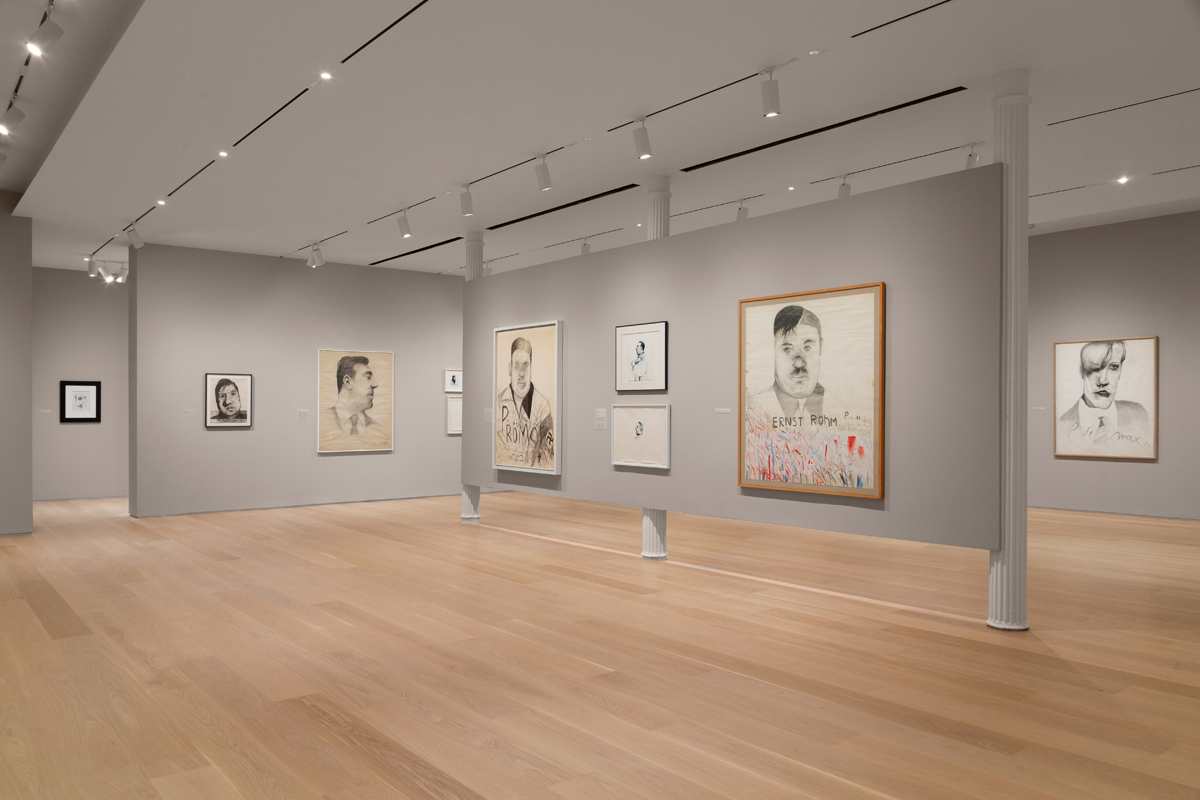
Stéphane Mandelbaum, installation view. Courtesy the Drawing Center. Photo: Daniel Terna. Pictured, on center freestanding wall, right: Ernst Röhm, 1981.
Stéphane Mandelbaum, organized by Laura Hoptman in collaboration with Susanne Pfeffer, the Drawing Center, 35 Wooster Street, New York City, through February 18, 2024
• • •
In the Drawing Center’s concise but substantial, quietly momentous introduction to the late Belgian artist Stéphane Mandelbaum (the first-ever solo exhibition of his transfixing, bewildering work in the United States), two larger-than-life paper-on-pencil busts of Ernst Röhm, Nazi commander of the SA, form a kind of queasy centerpiece. The 1981 images, rendered in a disconcertingly sensual style of realist caricature, are embellished or defaced. In the more polite one of the pair, a multicolor swath of rhythmic, slashing gestures stretches across the paper’s bottom, and the German officer’s name is spelled correctly. In the other, Mandelbaum spells it Röm, and the swastika armband in the lower right is cordoned off, compositionally, by an ejaculating penis.
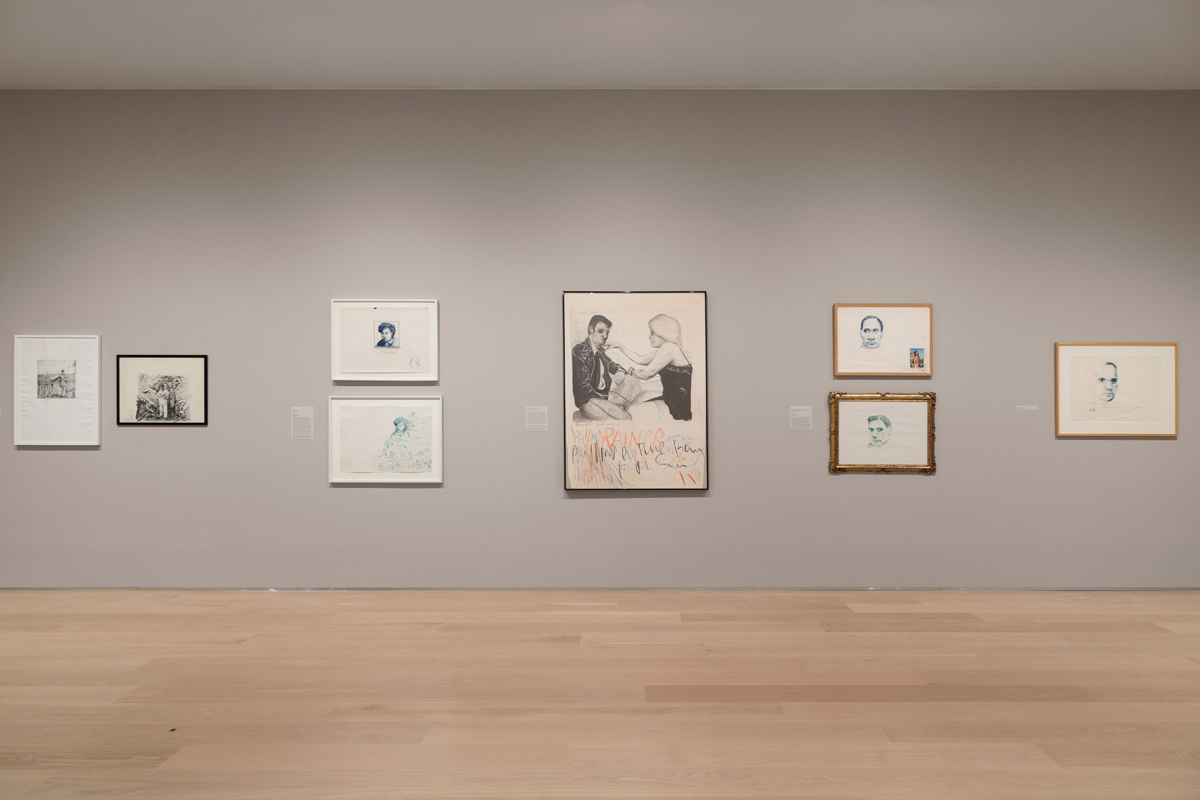
Stéphane Mandelbaum, installation view. Courtesy the Drawing Center. Photo: Daniel Terna. Pictured, center: Rainer (Portrait de Rainer Werner Fassbinder), ca. 1984.
The pictures serve to index some of the tendencies and motifs that also appear in the draftsman’s portrayals of family members, friends, and characters of a local demimonde, as well as distant villains and artistic heroes. Mandelbaum deployed, as a foil to his meticulous figuration, mark-making and text both canny and compulsive, hectoring and ruminative. More importantly, his Röhms preempt efforts to assign the artist—a third-generation Holocaust survivor—a fixed relationship to postwar memory culture or a comforting ethics of representation. In a very short-lived career devoted to depicting and performing transgression and trauma (Mandelbaum died at the age of twenty-five, in 1986), they stand, with their small eyes and full lips, as repulsive emblems of a portraiture practice that blurred homage and hex.
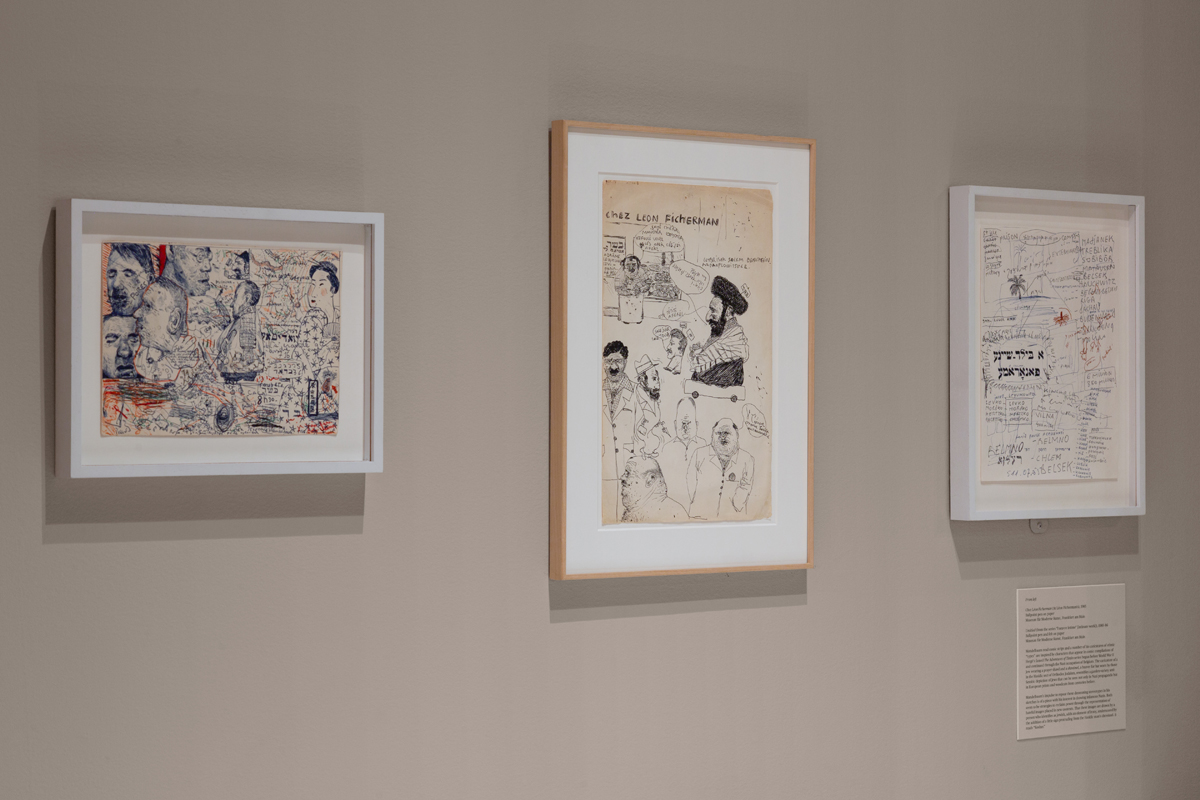
Stéphane Mandelbaum, installation view. Courtesy the Drawing Center. Photo: Daniel Terna. Pictured, far left: Composition (Mishima, Bacon...), 1980.
A similar-scale drawing of the artist’s father, from 1982, is only slightly less provocative and just as ambiguous. Arié Mandelbaum, a painter and a teacher at the art school his son attended, is shown in a suit and tie, modeled delicately in graphite, without a whiff of ridicule. He floats, disembodied and decontextualized—ghostly, unfinished, a fading snapshot—in white space. Beneath him, meticulous calligraphic lettering reads “kismatores!” (kiss my ass in Yiddish), while hell breaks loose in the left margin. Fragments of several languages rise in a column from a tiny collage in which the face of a smiling Nazi is grafted onto a pornographic fragment, a foreshortened view of a woman in just a garter belt and stockings.
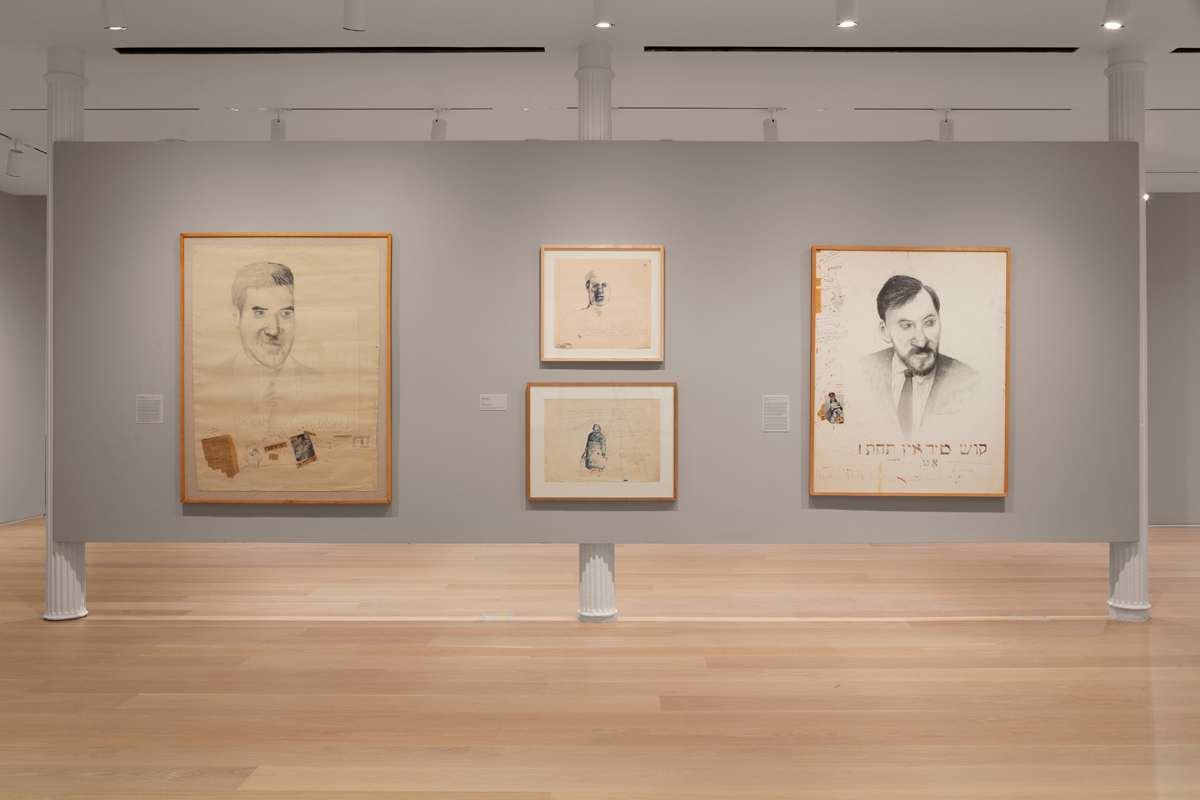
Stéphane Mandelbaum, installation view. Courtesy the Drawing Center. Photo: Daniel Terna. Pictured, far left: Pierre Goldman, 1980. Far right: Kismatores! (Portrait d’Arié Mandelbaum), 1982.
In other works, too, mixed messages, drawn from a reservoir of psychic runoff—lexical and visual treasure or detritus—appear as chaotic counterparts to central figures. A 1980 portrait of Pierre Goldman, the assassinated leftist guerrilla, bank robber, and author of Dim Memories of a Polish Jew Born in France, published in 1975, is similarly constructed, with snippets of porn, script, and news clippings scattered along the bottom. The smaller Salomon Mandelbaum [from a 1929 photo] (1981), which shows the artist’s grandfather, five years after he immigrated from Poland, is treated a little differently. Crowded into the lower left, an army of tiny stick figures, like ants with guns and tanks, advance west. Sometimes Mandelbaum incorporated lists into his compositions—the names of death camps, for example, or of the interviewees in Claude Lanzmann’s nine-hour documentary Shoah, released in 1985. It’s in these more automatic, abstract, or notational modes that the artist tried to represent the enormity of the Holocaust—or demonstrated that task’s impossibility.
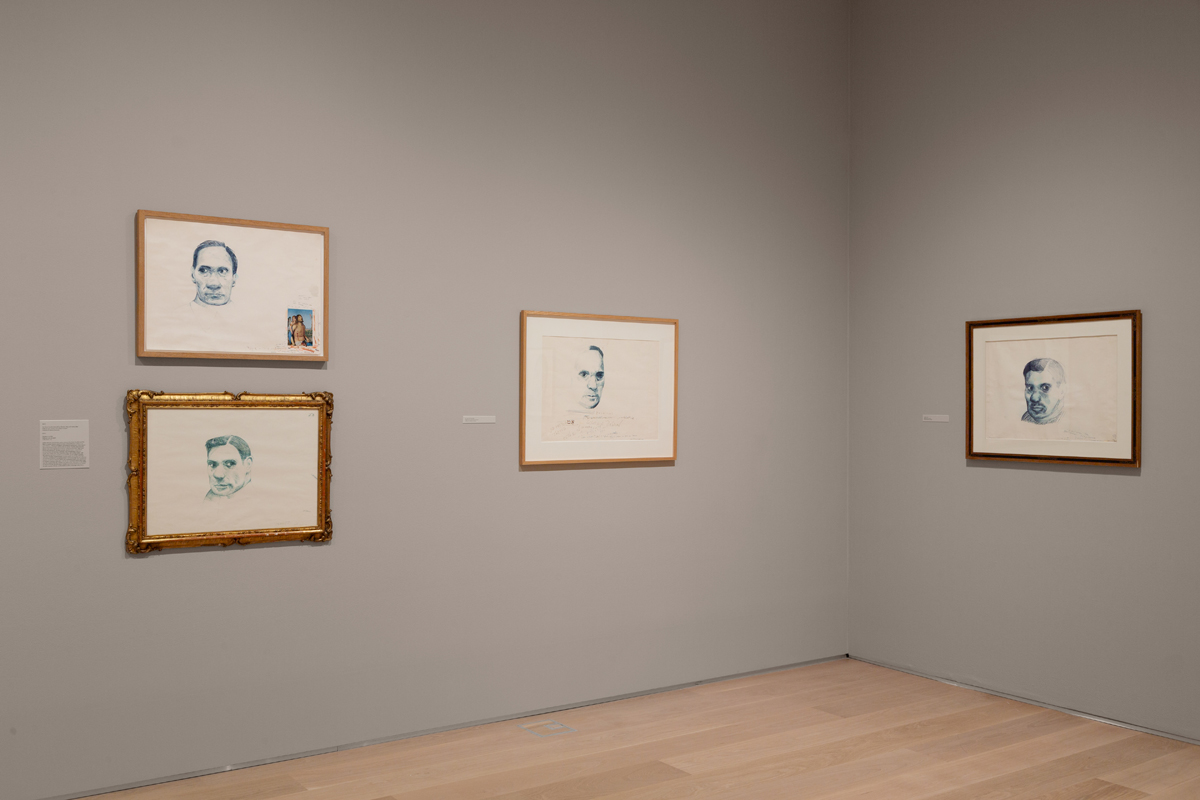
Stéphane Mandelbaum, installation view. Courtesy the Drawing Center. Photo: Daniel Terna. Pictured: drawings of Pier Paolo Pasolini, all 1980.
Strangely, a gay pantheon counters, or is engulfed by, the exhibition’s invocations of incalculable catastrophe. There are several versions of Pier Paolo Pasolini here, isolated heads in ballpoint pen. (In tribute to the filmmaker, a teenage Mandelbaum, on a trip to study Renaissance art, slept on the beach in Ostia where the filmmaker was killed.) Francis Bacon appears repeatedly, rendered with a special intensity (Mandelbaum drew George Dyer as well, the painter’s lover, who died by suicide). Also in the mix: Arthur Rimbaud, Yukio Mishima, and Rainer Werner Fassbinder. Röhm was gay, too (homosexuality was the pretense for Hitler’s assassination of a political rival). But Mandelbaum was not—or he wasn’t out. Regardless, a fascination with these figures, and their often-violent ends, appears fundamental to his self-concept. Libidinal and votive, the men’s portraits recall fan art, though Mandelbaum’s obsession was not with honoring his idols (or enemies) through a likeness. He favored distorted verisimilitude—echoing Egon Schiele or the exaggerations of comics—which he used, perplexingly, to emphasize vaguely “Semitic” features. His subjects look rather like one another, and they look like him, too. Everyone has roughly the same nose.
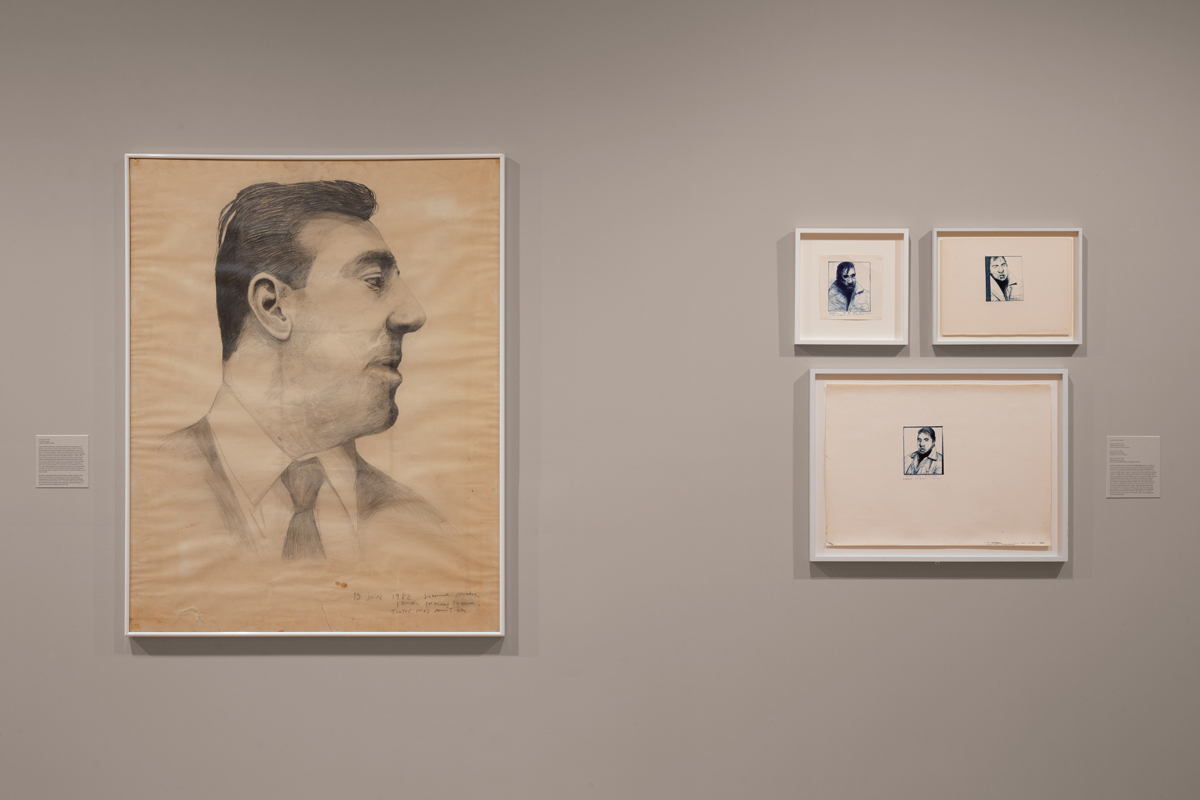
Stéphane Mandelbaum, installation view. Courtesy the Drawing Center. Photo: Daniel Terna. Pictured, left: George Dyer, 1982. Right: drawings of Francis Bacon, all 1980.
The physiognomic haze of these doubles isn’t the only way Mandelbaum disorients: in the gray-painted gallery, I had the sense that the work was from an earlier time. His imagery, together with his anachronistic figurative style, evokes the modernist “degeneracy” (per Hitler) of Dada and German Expressionism; it’s easy to forget that the artist was likely, given the era and his interests, more influenced by the purposely degenerate aesthetics of punk. In his desire to shock, to break taboos (when he scrawled “dirty Jew” on a drawing, for example, or lavished the same attention on a bellowing Joseph Goebbels as he did on Pasolini), he was operating in the tradition of a swastika-wearing Sid Vicious as much as that of Otto Dix or George Grosz—though none of these artists were Jews.

Stéphane Mandelbaum, installation view. Courtesy the Drawing Center. Photo: Daniel Terna. Pictured, clockwise from left: P. Röm (N°1 / Portraït of Röm), 1981; Goebbels, 1980; Goebbels [recto], 1980.
Curator Laura Hoptman, in a superb and riveting essay for the exhibition catalog, wrestles with Mandelbaum’s fierce adoption of a Jewish identity, or creation of a persona, in the context of his decisively countercultural affinities—and in response to the suggestion, by some scholars, that it was a kind of fetish. The artist, whose mother was not Jewish, grew up with little knowledge of Judaism; he learned about his Polish-Jewish background through his grandfather, as a teen. Unusually perhaps, for someone of his generation who inherited Jewish trauma but not tradition, his interest was not in Old Testament myth, Talmudic teachings, or the “muscular” New Jew envisioned by Zionist ideology. (Significantly, Mandelbaum taught himself Yiddish—the language of the murdered and dispossessed European Jewry—not Hebrew.) Instead, he found strength in, as Hoptman puts it, “weaponizing the dangerous cliché of the Jew as an outsider, a stateless iconoclast, and member of a shady cabal with its own secret language.” It was a risky approach that courted misunderstanding, paying off only later in the enigmatic power of his work.
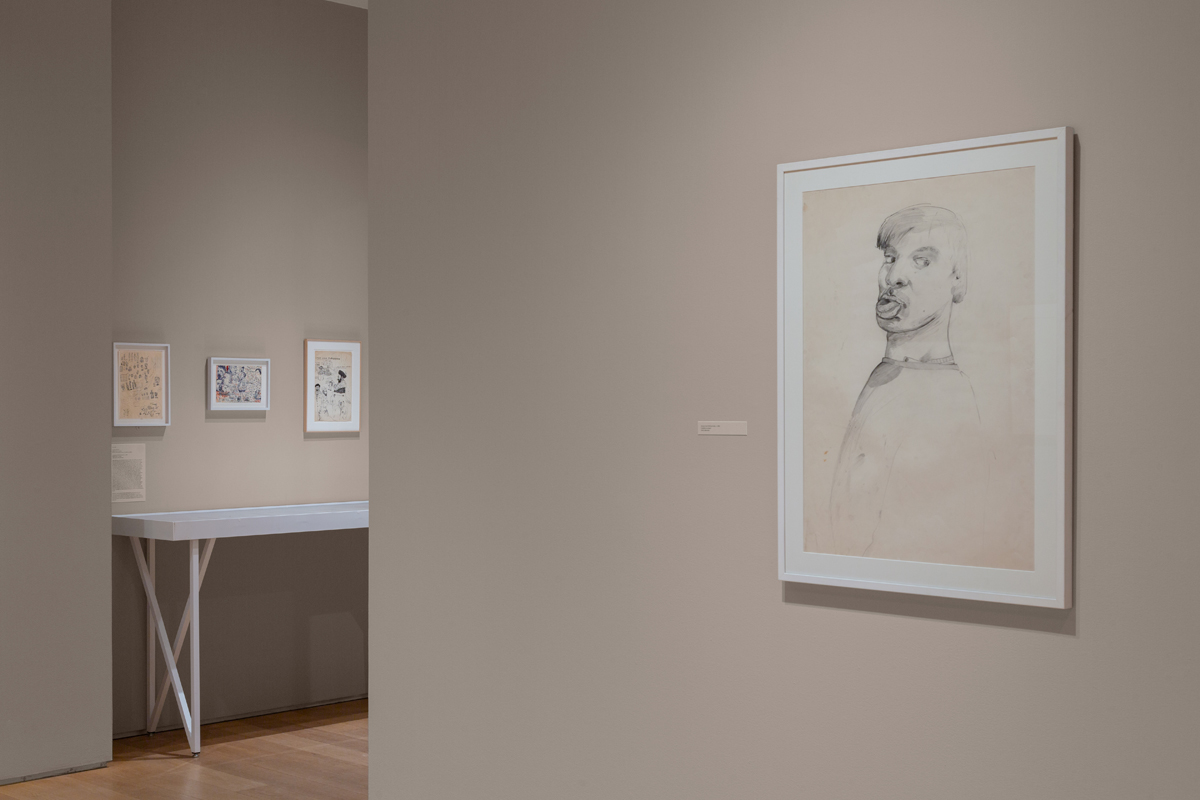
Stéphane Mandelbaum, installation view. Courtesy the Drawing Center. Photo: Daniel Terna. Pictured, right: Autoportrait (Self-portrait), ca. 1980.
Imagining his own gravestone, in 1986, the artist listed the dates of his life as 1901–1944, with the accompanying epitaph, “Jew who died in the camps by Nazi Germany,” so intense was his connection to the past. In fact, Mandelbaum died later that year, murdered by a crime syndicate for whom he stole a Modigliani, which turned out to be a fake. The incident made headlines, establishing his legend; Mandelbaum’s life (or rather his death) was ultimately more shocking than his art. Four decades later, though, his drawings still deliver a jolt—but not for their morbid portent, I think. While transgression was not an end in itself for Mandelbaum, when his monstrous reversals are irreconcilable with a project of social critique, it is difficult to know his purpose. To harrowing effect, he lays bare the impossible “remembering” of someone who lives in the aftermath of horror but was not there. I needed this show: the terrible puzzle of the work feels vital now because it is presented here—with exquisite care—during a new phase in the instrumentalization of Jewish trauma, when there is a narrower and freshly fraught set of institutionally and state-sanctioned lessons that artists (and writers) are permitted to draw from the Shoah.
Johanna Fateman is a writer, art critic, and musician in New York.